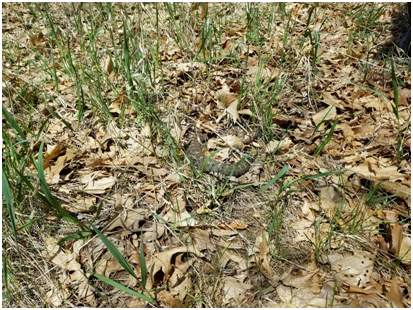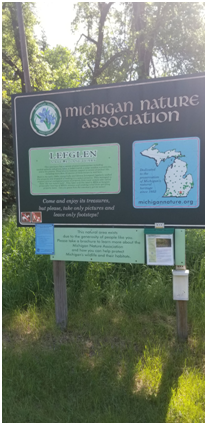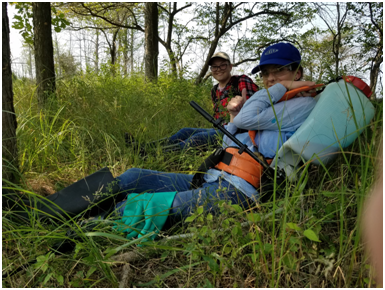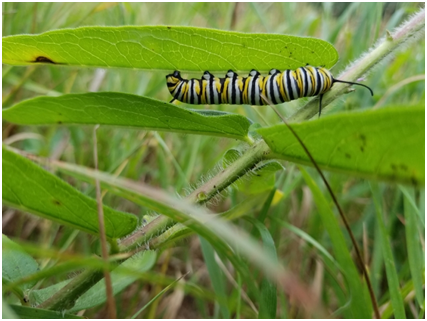Monday, Dec 17, 2018
By Hannah DeHetre, MNA Intern
The Michigan Nature Association is a land conservation organization that works to protect and preserve natural areas in Michigan by recruiting local volunteers to help maintain MNA sanctuaries as well as implementing conservation education. MNA was founded in 1952, as a bird study group, and now the organization owns and manages over 175 sanctuaries across Michigan. MNA relies heavily on volunteers and environmental stewardship. According to Rachel Maranto, the Stewardship Coordinator in the Lower Peninsula, volunteers are the “bread and butter” for MNA because “Michigan is such a big state and there are very few staff covering the state, so what is accomplished hinges on volunteer participation.”

A massasauga rattlesnake that we saw at one of the MNA sanctuaries this summer. The Massasauga is, as of 2016, listed as Threatened under the Endangered Species Act (Service, U. F.), demonstrating the importance of preserving MNA sanctuaries (photo: Rachel Maranto).
To manage over 175 sanctuaries across Michigan, volunteers come out and help with work days. Over the summer, the work days involved the removal of invasive species such as autumn-olive, garlic mustard, and phragmites. According to Maranto, the management practice that is predominately used to control phragmites is spraying of herbicide. Due to her limited time, volunteers, and funding, herbicide backpacks are the tools used to deal with phrags, and it normally takes three days throughout the season to hit all the phrags in Saginaw Wetlands. Maranto also said that ideally, she would like to try mowing the phrags in the winter when the ground is frozen, and then spraying in the spring so that the vegetation is shorter, and therefore less herbicide would have to be used and it would be easier to spray. According to Maranto, the main goal of MNA in dealing with phragmites, especially at Saginaw Wetlands, is containment. Right around the sanctuary is a large invasion of phragmites around Lake Huron, and so without large-scale cooperation, all MNA can do is control the phrag invasion within their own sanctuary.
This summer, I interned at the Michigan Nature Association as a Stewardship Assistant. I spent the summer traveling to sanctuaries all around southeastern Michigan doing site-monitoring, setting up boundary markers, and most importantly: removing invasive species. We used various techniques to remove invasive species (not just phrags), such as just pulling them out of the ground, herbicide spraying, and cutting the plant and dabbing herbicide sponges on the cut stem. During my time with MNA, I got to meet some really great and dedicated volunteers, who were taking time out of their day, in the heat, to make their neighborhood a nicer place by managing their local sanctuary. Maranto told me that MNA attracts volunteers who are engaged and dedicated to helping MNA, so whenever someone leaves, it is hard to fill their shoes. For a small-scale conservation organization like the Michigan Nature Association, volunteers are vital for invasive species management. This was an interesting thing for me to learn this summer, as it really emphasizes the importance of local people caring about their neighborhood.

The entrance sign to Leflgen Sanctuary (photo: Hannah DeHetre)
My last day interning for MNA was phrag spraying at Saginaw Wetlands. Rachel, another intern, and I spent hours walking around and spraying any phragmites that we saw. It was hot and sunny, I had on a really heavy herbicide backpack, and it was really hard work. It takes real dedication and passion to work that hard for a goal that some people think is impossible to achieve, and when I asked Maranto if she ever feels discouraged, or like she is fighting a losing battle, she said that overall she is not discouraged with the work the MNA does and any discouragement that she may feel just comes from a tough day spraying phrags in the heat. She also says that overall she has seen an improvement in the phrag management in the five years that she has worked for MNA. She says that typically, one year they spray a large stand of phragmites, the next year they are dead, and the following years, volunteers just have to come back and spray any repsouts- so there is improvement, which is why Maranto does not feel discouraged.
The areas around Saginaw Wetlands are really infested, and MNA has to fight against that, and as I said before, MNA’s goal in phragmites management is containment, and that the best invasive management practice is to discover the invasion and remove it before it can get out of control, which MNA is doing well. When asked about MNA’s future plans for dealing with phragmites, Maranto said that if resources and personnel do not change, then it will be more of the same: spraying herbicide with volunteers who are willing to help. However, if some sort of biocontrol were to be developed and implemented, MNA would be a willing participant in that management practice. Another opportunity that Maranto would be interested in would be more collaborating with neighbors of sanctuaries, and with the help of partners to share the administrative burden and workload, bigger equipment could be used for ecological management.

Another intern, Liz, and I taking a break after LOTS of phrag spraying. We still have a smile on our faces! (photo: Rachel Maranto)
The Michigan Nature Association is a conservation organization that manages and protects over 175 sanctuaries throughout Michigan. While working there this summer, I learned about and employed various management practices used by MNA to remove invasive species from their sanctuaries. More than that though, I learned about the power of local volunteers. These are people who just care about nature, and about their neighborhoods, and are willing to spend hours in the summer working hard outside for the sake of taking care of these sanctuaries. Effective conservation and management can only happen with the help of these volunteers (so go out and volunteer)!

Bonus: Monarch caterpillar that we saw at Saginaw Wetlands (photo: Rachel Maranto)
